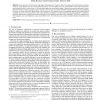Free Online Productivity Tools
i2Speak
i2Symbol
i2OCR
iTex2Img
iWeb2Print
iWeb2Shot
i2Type
iPdf2Split
iPdf2Merge
i2Bopomofo
i2Arabic
i2Style
i2Image
i2PDF
iLatex2Rtf
Sci2ools
VIS
2007
IEEE
2007
IEEE
Enhancing Depth-Perception with Flexible Volumetric Halos
Volumetric data commonly has high depth complexity which makes it difficult to judge spatial relationships accurately. There are many different ways to enhance depth perception, such as shading, contours, and shadows. Artists and illustrators frequently employ halos for this purpose. In this technique, regions surrounding the edges of certain structures are darkened or brightened which makes it easier to judge occlusion. Based on this concept, we present a flexible method for enhancing and highlighting structures of interest using GPU-based direct volume rendering. Our approach uses an interactively defined halo transfer function to classify structures of interest based on data value, direction, and position. A feature-preserving spreading algorithm is applied to distribute seed values to neighboring locations, generating a controllably smooth field of halo intensities. These halo intensities are then mapped to colors and opacities using a halo profile function. Our method can be used ...
Halo Intensities | Halo Profile Function | Halo Transfer Function | IEEE Visualization | VIS 2007 | Visualization |
| Added | 03 Nov 2009 |
| Updated | 03 Nov 2009 |
| Type | Conference |
| Year | 2007 |
| Where | VIS |
| Authors | Stefan Bruckner, M. Eduard Gröller |
Comments (0)

